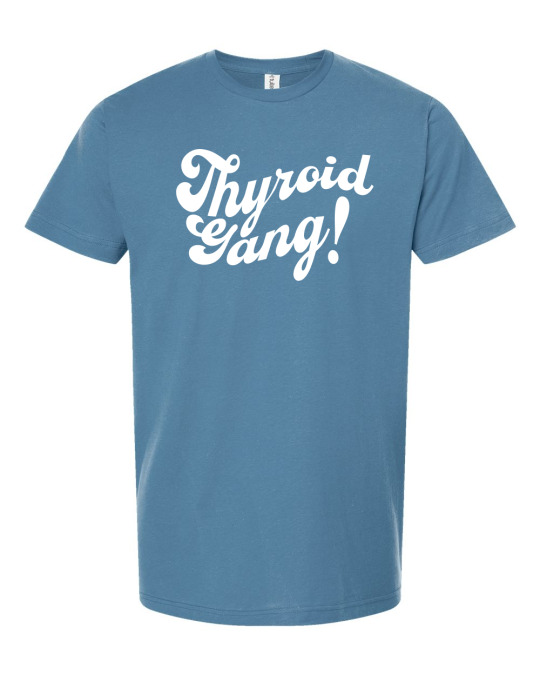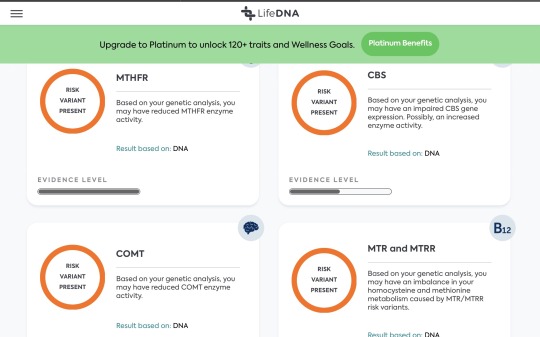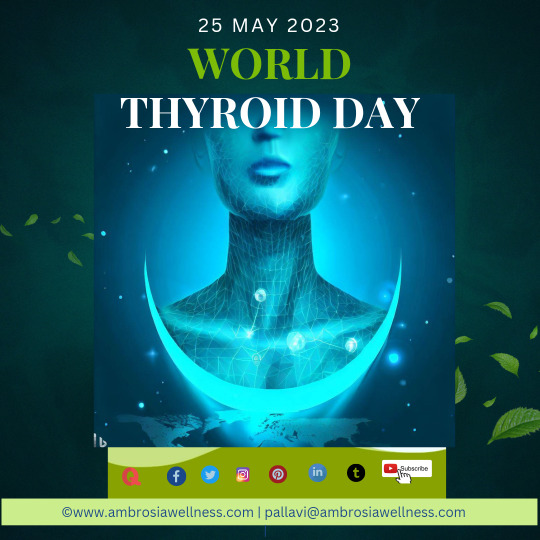#hypothyroid
Explore tagged Tumblr posts
Text

the thyroid is a butterfly shaped gland
(a piece about being newly diagnosed with Hashimoto’s and trying to research it)
#hashimotos thyroiditis#hashimoto’s disease#hypothyroidism#hypothyroid#Sam’s art#my art#artists on tumblr#not my usual but I don’t have an art blog so it’s going on the main#tw blood
3 notes
·
View notes
Text

#thyroidproblemsinwomen#glandsandhormones#ayurveda#treatment#thyroidgland#thyroid#ayurvedictreatment#howtocurethyroid#thyroidtreatment#thyroidcure#hypothyroidism#hyperthyroidism#thyroidsymptoms#hypothyroid#hypothyroidismnaturaltreatment#thyroidkailaj#thyroidhomeremedies#thyroiddiet#ayurvedictreatmentforthyroid#thyroidproblems
3 notes
·
View notes
Text
Probably time for a fundraiser shirt to keep the lights on.
Who else has a thyroid condition? Would you buy this?

16 notes
·
View notes
Text
Methylation
Methylation risk variant results MTHFR, CBS, COMT, MTR and MTRR I had a DNA test done through ancestry. I sent the results to Life DNA and got some information. They had an offer on methylation genes so I had that analyzed. Out of 10 genes, 7 had risk variants. The variants are not unusual. Some of them lead to an increase in homocysteine which when increased can be a heart attack risk. I …

View On WordPress
#alcohol#Ancestry#folate#hashimotos#hypothyroid#inflammation#Life DNA#mental illness#methylation#psychiatrist#Sam-e#supplements
6 notes
·
View notes
Video
youtube
Top 10 Foods Rich In Iodine
Iodine is an essential mineral that is vital for the proper functioning of the thyroid gland. This gland plays a crucial role in regulating metabolism, growth, and development. The suggested daily amount of iodine intake, also known as the recommended daily intake (RDI), is 150 micrograms per day for the majority of adults. Nevertheless, for women who are expecting or breastfeeding, the necessary amount is greater. While iodine deficiency is rare in many developed countries due to the widespread use of iodized salt, it still affects millions of people worldwide. The deficiency of iodine can lead to thyroid problems, such as goiter, hypothyroidism, and cretinism. Therefore, it is important to consume foods that are rich in iodine to maintain optimal thyroid function.
Here are the top 10 foods rich in iodine.
1. Seaweed Seaweed is a type of marine algae that is incredibly rich in iodine. In fact, seaweed is one of the most concentrated natural sources of iodine available. It's important to note that not all types of seaweed contain high levels of iodine, so it's best to do some research before adding it to your meals. Some popular varieties include kelp, nori, wakame, and dulse. Seaweed can be enjoyed in salads, soups, sushi rolls, or even as a seasoning on top of roasted vegetables.
2. Shrimp Shrimp is an excellent source of iodine, providing approximately 35 micrograms of iodine in a 3-ounce serving. For optimal iodine intake, it is recommended to choose fresh or frozen shrimp over canned varieties, as they typically contain higher levels of iodine. In addition to iodine, shrimp is also packed with other essential nutrients such as protein, omega-3 fatty acids, and vitamin B12.
3. Oysters Oysters, a type of shellfish, are a nutritional powerhouse. They are rich in essential nutrients, particularly iodine. Consuming only six medium-sized oysters can provide you with more than double the recommended daily intake of iodine. Oysters are also rich in protein and omega-3 fatty acids. Additionally, oysters are low in calories, making them a great food choice for those who are trying to lose weight or maintain a healthy diet.
4. Scallops Scallops are a type of shellfish that are known for their sweet and delicate flavor. They are also a great source of iodine. A 3-ounce serving of scallops contains approximately 35 micrograms of iodine, which is more than 20% of the recommended daily intake. Moreover, They're also a great source of protein and low in fat. You can enjoy them grilled, sautéed, or even raw in sushi.
5. Tuna Tuna is an exceptional source of iodine, providing a wealth of health benefits. A 3-ounce serving of canned tuna contains approximately 17 micrograms of iodine, which is about 11% of the recommended daily intake. Additionally, tuna is also a great source of protein, omega-3 fatty acids, and other nutrients that are important for overall health. You can enjoy tuna in a salad, sandwich, or even as sushi.
6. Cod Cod is a popular white fish that is also rich in iodine. A 3-ounce serving of cod contains approximately 99 micrograms of iodine, which is more than 65% of the recommended daily intake. Moreover, it also provides other important nutrients such as omega-3 fatty acids, vitamin D, and selenium.
7. Squid Squid is an excellent source of iodine. Just 3 ounces of cooked squid contain approximately 720 micrograms of iodine, which is more than four times the recommended daily intake. Squid is also rich in other nutrients like vitamins B12 and D, as well as omega-3 fatty acids. You can enjoy squid in various ways such as grilled, stir-fried, or even deep-fried as calamari rings.
8. Crab Crab is another seafood that is high in iodine. A 3-ounce serving of crab contains about 90 micrograms of iodine, which is nearly 60% of the recommended daily intake. Additionally, crab is a low-fat and high-protein food that provides several other important nutrients, like vitamin B12, selenium, and omega-3 fatty acids. Not only does it taste great on its own, but it can be added to a variety of dishes like salads or soups.
9. Eggs Eggs are a great source of iodine, with one large egg containing approximately 24 micrograms of iodine, which is about 16% of the daily recommended intake, making them a great choice whether you're enjoying them as part of a breakfast spread or adding them to salads, sandwiches, or stir-fries.
10. Dairy Dairy products such as milk, cheese, and yogurt are excellent sources of iodine. This is because cows are typically fed iodine-rich feed, and their milk contains high levels of this nutrient. Just one cup of milk can provide up to 56 micrograms of iodine, making it one of the easiest ways to meet your daily needs. Other dairy products like cheese and yogurt also contain significant amounts of iodine. However, remember to choose low-fat options to avoid excess saturated fat consumption. In addition, cheese and yogurt are fermented, which can increase the bioavailability of iodine. Dairy products are not only a great source of iodine but also provide other important nutrients such as calcium, protein, and vitamin D. However, people who are lactose intolerant or have milk allergies should look for other sources of iodine.
#youtube#iodine#thyroid#thyroidfood#food#foods#diet#healthyfood#healthyfoods#superfood#superfoods#thyroidgland#squid#goiter#hypothyroidism#hypothyroid
5 notes
·
View notes
Text
Not me showing up late to work bc I couldn't fucking wake up & immediately saying I'm having physical symptoms of my underactive thyroid
Bc the last time this happened at a job no one bothered to ask me what was wrong. Or why I went from a stellar employee to doing the bare minimum & not caring. And then a coworker complained to the boss & without consulting me, who obviously had a Problem, I was moved to a different department as punishment. Where I had to deal with Debra.
Full disclosure that was at one of Clean Harbors' incineration plants, which gave me a fucking ton of other horror stories.
#personal#hypothyroid#and with this happening that place felt just like home (childhood dynamics)#i grew up in 'never ever talk abt a problem' and im extremely avoidant of talking abt problems!!! imagine that#tho i think i do that less bc sb accused me of being awful things when i was just plain avoidant & it made me so fucking mad i-#-overcorrected my behavior and built concrete walls around myself and now i dont feel love#🤷 cptsd
1 note
·
View note
Text

https://manjirinadkarni.com/services
#healthy lifestyle#inflammation#thyroid#hypothyroid#hyperthyroid#holistic food#ayurveda#ayurveda canada#holistic healing#digestion#gut health#holistic health
1 note
·
View note
Text


क्या आपने कभी सोचा है कि क्या पपीता सभी के लिए सुरक्षित है?
हाँ, पपीता अति स्वास्थ्यवर्धक है। लेकिन, हाइपरथायरायडिज्म से पीड़ित लोगों के लिए ख़तरनाक होता है ये फल😱
#hypothyroidism#thyroid#thyroidhealth#hypothyroid#hashimotosdisease#hashimotos#autoimmunedisease#weightloss#thyroidhealing#thyroidproblems#healthylifestyle#hyperthyroidism#weightlossjourney#health#thyroiddisease#autoimmune#thyroidwarrior#diabetes#pcos#fitness#chronicillness#guthealth#hashimotosthyroiditis#hypothyroidismweightloss#thyroidawareness#thyroidweightloss#hormones#gravesdisease#chronicfatigue#medixic
1 note
·
View note
Text
Happy New Years Day, y’all!!
I did not even make it to midnight but I woke up next to a few of my favorite things:
1.) My cat, Tail
2.) My husband

My husband has always been there for me and this year was a very difficult year for me. I went well down into my anger and depression and started to see a therapist (2 therapist, actually. Stupid insurance changing). With the first, we figured out that I’m scared that I’m not loved or won’t be loved by those who love me or that I just don’t feel like I’m enough. Which made a lot of sense cause there have been moments with in my family where I don’t feel any love and yet I’m suppose to still be here. With my second therapist, she’s giving me advice on how to work on controlling my anger/irritation and to get back to my old self again, let my guard/wall come down for good.
I’m learning again to communicate and talk my emotions out, instead of keeping them inside and building up my anger and negative thoughts.
I’m learning how to reconnect with my husband again and to make him feel loved too.
Just lots of other things that I will do in this new year, and I want to see a difference by the end of 2024.
✨🤞🏻💗
0 notes
Text
IVF Fertility Clinic In Vashi

How Hypothyroid Affect Mother and Child High Blood Pressure In Pregnancy Anemia Low Birth Weight Miscarriage Affect Overall Growth And Development of the baby.
#hypothyroidmotherandchild#hypothyroid#hypothyroidism#thyroid#thyroidhealth#thyroidproblems#hyperthyroid#thyroidawareness#gynecologistforthyroidproblems#doctorforthyroidproblem#thanwalamaternityhome
0 notes
Text
heeeey question for ya'll with hypothyroidism - so my doc ran a thyroid test but it took 3 years of presenting symptoms to even get this screen, even though its pretty common in diabetics and im thinking my levels are gonna have to be way out of range for them to do anything for me. Is there any over the counter supplements/vitamins/anything that helps? something i can take while im working on a diagnosis?
1 note
·
View note
Text
Reverse T3 Helpful or Waste of Time?
Reverse T3, Helpful, or Waste of Time? Linda is a stay at home mom sitting in my office with Hashimoto’s autoimmune thyroid disease with typical symptoms of fatigue, hair loss and weight gain despite taking levothyroxine 125 mcg/d prescribed by her endocrinologist. Linda asks me the question: Why isn’t the thyroid pill working for me? Linda’s initial thyroid labs last year before starting…

View On WordPress
0 notes
Text

Do the thyroid test.Take initiatives to tackle thyroid diseases. Promise yourself to stay healthy. Yes, we can win against Thyroid diseases. #canwin Share your awareness story against Thyroid. Need help, we are here.
#worldthyroidday #thyroid #hypothyroidism #levothyroxine #hashimotos #may #hyperthyroidism #fatigue #thyroidawareness #autoimmunedisease #thyroidtreatment #synthroid #thyroidcancer #weightgain #autoimmune #underactivethyroid #awareness #health #thyroiditis #hypothyroid #thyroidproblems #thyroiddisease
https://www.ambrosiawellness.com/blog/
#didyouknow#worldthyroidday#fatigue#hypothyroidism#hypothyroid#livehealthy#eatright#thyroiddisease#thyroidproblems#endocrinology
0 notes
Text
Hypothyroid 🤔
#pay attention#educate yourselves#educate yourself#knowledge is power#reeducate yourselves#reeducate yourself#think about it#think for yourselves#think for yourself#do your homework#do your research#do some research#do your own research#ask yourself questions#question everything#for your health#health tips#healthy living#hypothyroidism#medical system
471 notes
·
View notes
Text





Assorted updates!! Dragonfruit is a……..girl!! I sent a very private photo to @talesfromtreatment who let me know that what I was seeing was in fact a very swollen vulva. I separated her from her sisters to see if perhaps there was some covert suckling going on and the swelling went down rapidly. Naughty, whoever was doing that suckling!
Cantaloupe is growing! She’s now 170g to her sisters’ 230. I still think she may have hypothyroidism, but the current plan is to wait for her four week checkup and draw blood then if she’s still tiny and weird looking. She also sleeps a LOT more than her sisters.
Banana is plomp. Round. Loud AF. And perfect.
I have included two pictures of Cantaloupe’s skin after we got her diarrhea managed. Despite my best efforts to keep her clean, she wound up with some fecal scald on her back legs and tail. Pictured is her back foot before and after two applications of A&D ointment. I’m freaking impressed. Next time I have a diarrhea kitten I’m using the A&D pre-emptively to protect the skin BEFORE it gets all scaly.
430 notes
·
View notes